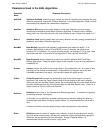
Using The Reverb Program Lexicon, Inc.
phrases. Reflections alter our sense of direction,
distance, and hall shape in ways that depend on the
duration and complexity of the notes, and on the
properties of the spaces between notes.
But human perception is more complex than just
direction, distance, and room shape. We are reacting to
the music on quite a different plane. Directional
localization is not an object in itself – it is a tool that
helps us separate one musical line from another, and
thus helps us grasp the intellectual and emotional
content of the music. The sense of space is also not
particularly interesting in itself. It is the emotional effect
of the space that makes the perception worth the
trouble. It is hard to separate the awe inspired by the
sound of a Gothic cathedral from Gregorian chant –
chant was developed to work alongside this awe, and to
enhance it. Listen to the cellos and basses play a
pizzicato bass line in a dead opera house, and feel how
each note falls lifeless. Add an enveloping
reverberation and each note takes a life of its own –
swirling around us as the notes decay and pull on our
heart with sadness or joy. Are we aware of these
effects? A trained listener can be, but most listeners
can only describe the emotional impact. This impact
can be very real.
The sense of distance has a similar emotional effect.
When the direct sound is too strong voices and
instruments seem to be stuck to the speaker – up front
and in-your-face. This perception is particularly strong
when a engineer tries a 5.1 mix for the first time. Put
the vocals in the center speaker and Bam! they whack
you in the face. The up-front perception is
psychologically important. But you want to use it with
great caution. Sometimes it is just the effect you want,
but after a sustained period the listener can tire, and
psychologically back away. This is probably one of the
reasons many engineers raised on two channel stereo
prefer a phantom center to a hard center. The phantom
may be just as up-front, but there is no speaker in that
position, so it seems more acceptable.
There is another solution. Humans perceive distance in
large part through the strength and time behavior of
reflected sound. In a typical room the direct sound
arrives uncorrupted by reflections. If the sound has a
fast rise-time the ear is able to determine the direction
of the sound by using the interaural time delay and the
interaural level differences as cues. After 10ms or more
reflections start to arrive – contaminating the time and
level differences and making localization difficult. Our
brains are able to use this reduction in localizability of
the sound as a distance cue – the degree to which
precise localization is reduced after the onset of a note
is a cue to both the size and the furnishings in a room.
Reflections from almost any direction EXCEPT the
direction of the sound source can create this sense of
distance, and they can come at a great variety of times
after the direct sound. However, there are optimal
directions and optimal times. The optimal direction is
frequency dependent. For frequencies below 700Hz
the optimal direction is from the side (90 degrees from
the front). At about 1500Hz the optimal direction
is +/- 30 degrees from the front (the standard front
speaker angle.) Reflections that arrive earlier than
about 15ms from the direct sound begin to interfere with
localization, and can cause comb filtering and timber
alteration. Reflections that arrive more than 50ms after
the direct sound can be heard as separate sound
events, and can cause serious problems with
intelligibility.
Thus if we add reflections to the left and right front
speakers and the left and right rear speakers, and
adjust the time delay so these reflections occur
between 15ms and 50ms, we can move the vocals out
of our center speaker. The vocals are pushed back into
a space behind the front speaker array. It seems
magical – we are increasing the perceived distance to a
source in the center speaker by adding reflections to all
the other speakers EXCEPT the center speaker – yet
this is the result of some very simple psychophysics.
Remember that we are not perceiving the individual
reflections separately – we are only perceiving their
ability to mess up the localization of the direct sound.
Because there is no actual perception of the reflections
themselves the distance perception (perhaps the
"room" perception would be a better description) is
bound to the direction of the direct sound. If the direct
sound comes from the center speaker, the "room"
impression seems concentrated in the front of the
listening space, even though the reflections that
produce it are coming equally from the front and the
rear. Switch the direct sound to the left rear, and the
"room" impression also switches to the left rear, even
without altering the reflection patterns at all.
Thus for producing the perception of "room" or "depth"
it is not necessary to have reflection patterns that mimic
a particular source position in a particular room. It is
only necessary that the reflections be primarily in
loudspeakers NOT in the same direction as the sound
source, and that the time delays of the reflections in
each loudspeaker should be different. This makes our
life much simpler – we can use a two channel echo
Reverberation and Reality, Continued
5-2


















